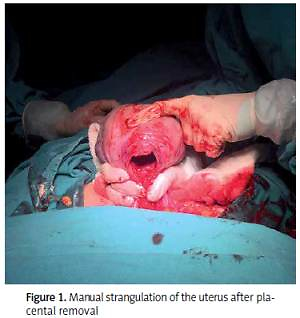Current issue
Archive
Manuscripts accepted
About the Journal
Editorial office
Editorial board
Section Editors
Abstracting and indexing
Subscription
Contact
Ethical standards and procedures
Most read articles
Instructions for authors
Article Processing Charge (APC)
Regulations of paying article processing charge (APC)
OBSTETRICS AND GYNAECOLOGY / CLINICAL RESEARCH
Manual strangulation of the uterine isthmus after placental removal to reduce blood loss during cesarean section
1
Süleymaniye Maternity and Education and Research Hospital, Istanbul, Turkey
Submission date: 2018-02-20
Final revision date: 2018-06-04
Acceptance date: 2018-06-18
Online publication date: 2019-12-03
Publication date: 2021-07-16
Arch Med Sci 2021;17(4):915-919
KEYWORDS
TOPICS
ABSTRACT
Introduction:
This study aimed to evaluate the effect of manual strangulation of the uterine isthmus on the amount of blood loss during cesarean section.
Material and methods:
This is a prospective randomized controlled trial. A total of 118 participants were enrolled in the study. Manual strangulation of the uterine isthmus just after placental removal was performed during cesarean section in group I (n = 57; the strangulation group). Strangulation was not performed in group II (n = 61; the control group). Preoperative and postoperative venous blood hemoglobin, capillary hemoglobin, and absorbed blood levels during the operation were compared between the two groups.
Results:
The median age of the patients was 28.5 (19–41). The median body mass index of the patients in the study was 27 (21–42). There were no significant differences in the demographic characteristics of the patients between the groups. The median difference between the preoperative and postoperative 4–6 h capillary hemoglobin values was significantly lower in the strangulation group (2.0 (0–9)) than in the control group (3.0 (0–8)). The amount of absorbed blood during the operation was also significantly lower in the strangulation group (164.5 ml (69–1310)) than in the control group (230 ml (35–3223)).
Conclusions:
Manual uterine strangulation of the uterine isthmus immediately after the removal of the placenta may induce a 30% decrease in blood loss during cesarean section.
This study aimed to evaluate the effect of manual strangulation of the uterine isthmus on the amount of blood loss during cesarean section.
Material and methods:
This is a prospective randomized controlled trial. A total of 118 participants were enrolled in the study. Manual strangulation of the uterine isthmus just after placental removal was performed during cesarean section in group I (n = 57; the strangulation group). Strangulation was not performed in group II (n = 61; the control group). Preoperative and postoperative venous blood hemoglobin, capillary hemoglobin, and absorbed blood levels during the operation were compared between the two groups.
Results:
The median age of the patients was 28.5 (19–41). The median body mass index of the patients in the study was 27 (21–42). There were no significant differences in the demographic characteristics of the patients between the groups. The median difference between the preoperative and postoperative 4–6 h capillary hemoglobin values was significantly lower in the strangulation group (2.0 (0–9)) than in the control group (3.0 (0–8)). The amount of absorbed blood during the operation was also significantly lower in the strangulation group (164.5 ml (69–1310)) than in the control group (230 ml (35–3223)).
Conclusions:
Manual uterine strangulation of the uterine isthmus immediately after the removal of the placenta may induce a 30% decrease in blood loss during cesarean section.
Share
RELATED ARTICLE
We process personal data collected when visiting the website. The function of obtaining information about users and their behavior is carried out by voluntarily entered information in forms and saving cookies in end devices. Data, including cookies, are used to provide services, improve the user experience and to analyze the traffic in accordance with the Privacy policy. Data are also collected and processed by Google Analytics tool (more).
You can change cookies settings in your browser. Restricted use of cookies in the browser configuration may affect some functionalities of the website.
You can change cookies settings in your browser. Restricted use of cookies in the browser configuration may affect some functionalities of the website.



